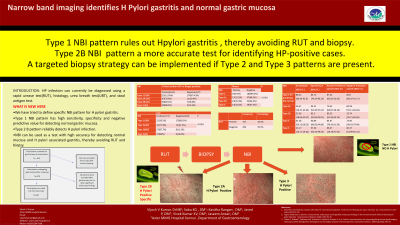Tuesday Poster Session
Category: Stomach
P4183 - Narrow Band Imaging Identifies H. pylori Gastritis and Normal Gastric Mucosa
Tuesday, October 24, 2023
10:30 AM - 4:00 PM PT
Location: Exhibit Hall

Has Audio

Vijosh v. Kumar, MD
Aster MIMS Hospital Kannur
Kannur, Kerala, India
Presenting Author(s)
Vijosh v. Kumar, MD, Sabu KG, DM, Javed P, DM, Kavitha Rangan, DM, Vivek Kumarkv, DM, Jaseem Ansari, DM
Aster MIMS Hospital Kannur, Kannur, Kerala, India
Introduction: Helicobacter pylori infection is a common cause of chronic gastritis and an established risk factor for gastric malignancy. The endoscopic appearances predicting H. pylori status are an ongoing area of research, as are their diagnostic accuracies. Conventional non-endoscopic examinations for diagnosis of H. pylori infection including stool antigen testing, serology, and urea breath test deliver a high rate of diagnostic accuracy for H. pylori infection status. However, these examinations cannot evaluate endoscopic findings such as gastric mucosal atrophy and intestinal metaplasia which are well-known risk factors for gastric carcinoma. Our study aims to establish the diagnostic accuracy of several NBI mucosal features predictive of H. pylori negative and positive status
Methods: This prospective study recruited patients from the Department of Gastroenterology at Aster MIMS Hospital in Kannur who had undergone gastroscopy for various reasons. 361 of 502 eligible patients were recruited; the rest were ineligible. Gastroscopy with NBI magnification was performed. It identified four patterns namely type 1, type 2, type 2A, type 2B, and type 3 patterns. H pylori was diagnosed using histopathology and rapid urease test.
Results: 164 of 361 patients had H pylori (45.42 percent). 361 people had 199 Type 1 (55.12%), 54 Type 2a (14.95%), 65 Type 2b (18%), and 43 Type 3 cases (11.91 percent). 87% of H pylori-negative patients had type 1 NBI. 79.5 percent of H pylori infections had type 2A patterns. 89.2% of H pylori infections had type 2B patterns. The type 1 pattern identified normal gastric mucosa with 84.75 percent sensitivity, 88.32 percent specificity, 87.4 percent negative predictive value, and 87 percent accuracy. Type 2 and type 3 NBI patterns had high positive predictive value and specificity for H pylori infection. Type 2 NBI showed increased sensitivity of 61%, specificity of 90%, and positive predictive value of 84%. Type 2B had 35 percent sensitivity, 82.50 percent specificity, and 89.23 percent positive predictive value compared to type 2A.
Discussion: Our findings strongly recommend using the NBI pattern to rule out H pylori infection. A targeted biopsy strategy can be implemented if Type 2 and Type 3 patterns are present.
Disclosures:
Vijosh v. Kumar, MD, Sabu KG, DM, Javed P, DM, Kavitha Rangan, DM, Vivek Kumarkv, DM, Jaseem Ansari, DM. P4183 - Narrow Band Imaging Identifies H. pylori Gastritis and Normal Gastric Mucosa, ACG 2023 Annual Scientific Meeting Abstracts. Vancouver, BC, Canada: American College of Gastroenterology.
Aster MIMS Hospital Kannur, Kannur, Kerala, India
Introduction: Helicobacter pylori infection is a common cause of chronic gastritis and an established risk factor for gastric malignancy. The endoscopic appearances predicting H. pylori status are an ongoing area of research, as are their diagnostic accuracies. Conventional non-endoscopic examinations for diagnosis of H. pylori infection including stool antigen testing, serology, and urea breath test deliver a high rate of diagnostic accuracy for H. pylori infection status. However, these examinations cannot evaluate endoscopic findings such as gastric mucosal atrophy and intestinal metaplasia which are well-known risk factors for gastric carcinoma. Our study aims to establish the diagnostic accuracy of several NBI mucosal features predictive of H. pylori negative and positive status
Methods: This prospective study recruited patients from the Department of Gastroenterology at Aster MIMS Hospital in Kannur who had undergone gastroscopy for various reasons. 361 of 502 eligible patients were recruited; the rest were ineligible. Gastroscopy with NBI magnification was performed. It identified four patterns namely type 1, type 2, type 2A, type 2B, and type 3 patterns. H pylori was diagnosed using histopathology and rapid urease test.
Results: 164 of 361 patients had H pylori (45.42 percent). 361 people had 199 Type 1 (55.12%), 54 Type 2a (14.95%), 65 Type 2b (18%), and 43 Type 3 cases (11.91 percent). 87% of H pylori-negative patients had type 1 NBI. 79.5 percent of H pylori infections had type 2A patterns. 89.2% of H pylori infections had type 2B patterns. The type 1 pattern identified normal gastric mucosa with 84.75 percent sensitivity, 88.32 percent specificity, 87.4 percent negative predictive value, and 87 percent accuracy. Type 2 and type 3 NBI patterns had high positive predictive value and specificity for H pylori infection. Type 2 NBI showed increased sensitivity of 61%, specificity of 90%, and positive predictive value of 84%. Type 2B had 35 percent sensitivity, 82.50 percent specificity, and 89.23 percent positive predictive value compared to type 2A.
Discussion: Our findings strongly recommend using the NBI pattern to rule out H pylori infection. A targeted biopsy strategy can be implemented if Type 2 and Type 3 patterns are present.
Disclosures:
Vijosh Kumar indicated no relevant financial relationships.
Sabu KG indicated no relevant financial relationships.
Javed P indicated no relevant financial relationships.
Kavitha Rangan indicated no relevant financial relationships.
Vivek Kumarkv indicated no relevant financial relationships.
Jaseem Ansari indicated no relevant financial relationships.
Vijosh v. Kumar, MD, Sabu KG, DM, Javed P, DM, Kavitha Rangan, DM, Vivek Kumarkv, DM, Jaseem Ansari, DM. P4183 - Narrow Band Imaging Identifies H. pylori Gastritis and Normal Gastric Mucosa, ACG 2023 Annual Scientific Meeting Abstracts. Vancouver, BC, Canada: American College of Gastroenterology.
